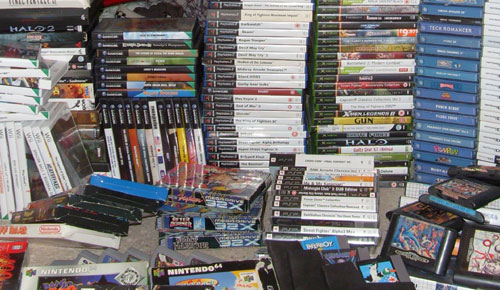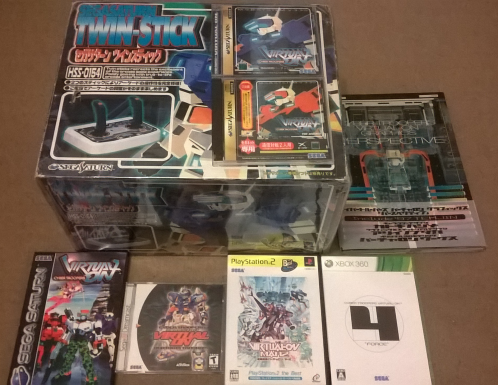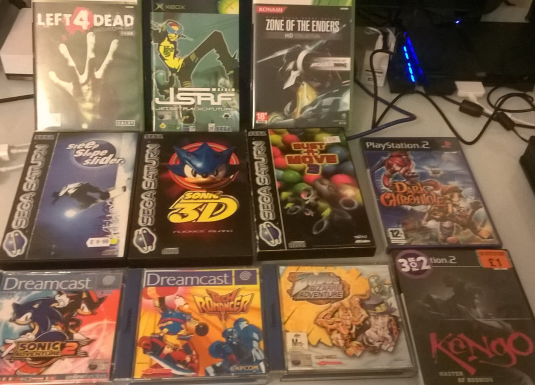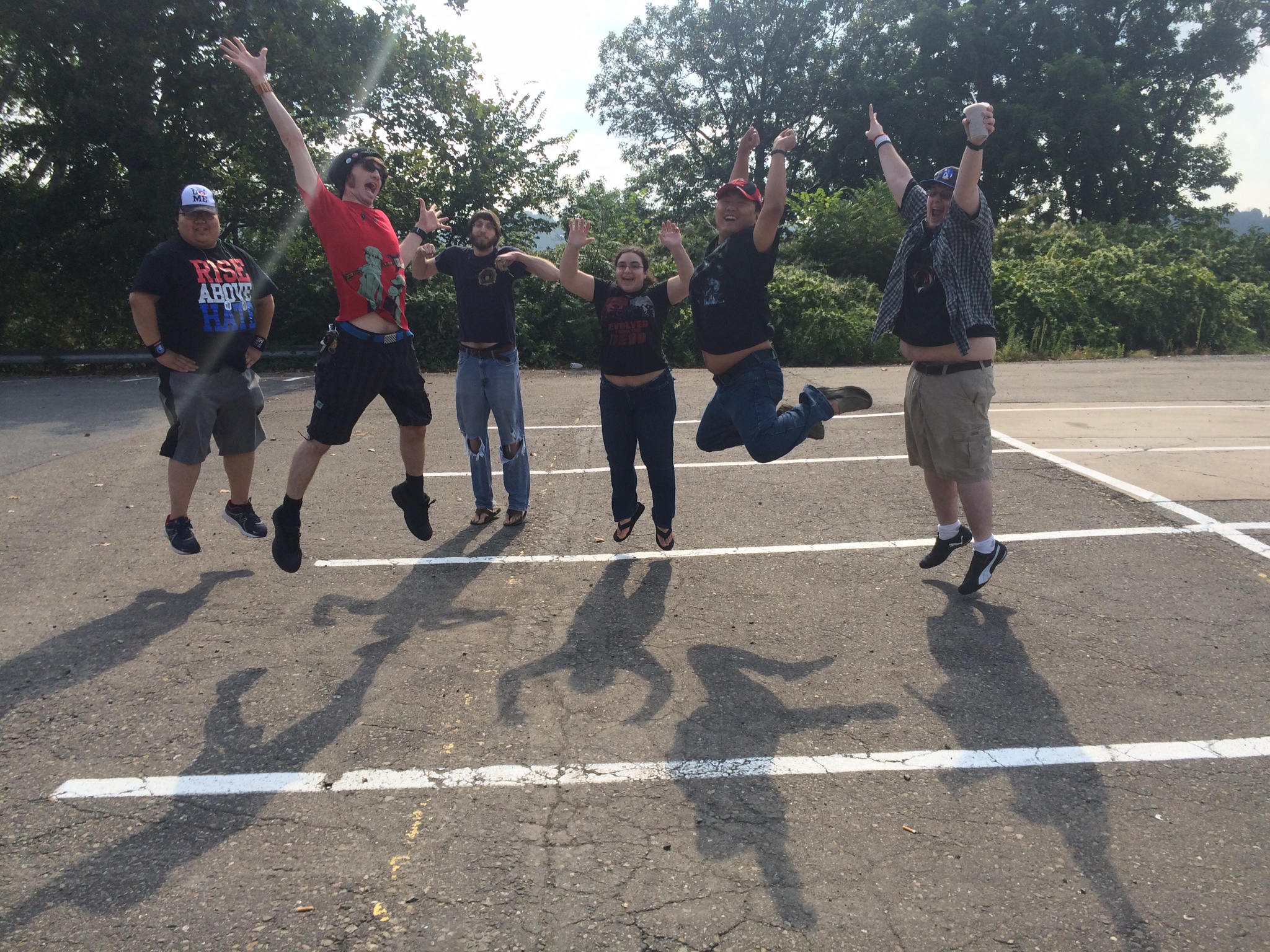One man, Harry Nezumi — some say brave, others foolish — stands against his backlog. With but five months between now and a move some 9,000 kms from home, does he have what it takes to complete all the outstanding games in his collection? Follow his quest, his Sisyphean toil, here on Sega Addicts as he tackles one hundred and seven games over twenty weeks. The journey will not be easy, the day grows dark and the hour late. Yet there is hope. With nine more games served up, did Harry complete the lot, or will their be more postponements and more defeats? Find out below.
Completed: Virtua Fighter 5 Final Showdown (XBLA); Rival Schools (PS); Project Justice Rival Schools 2 (DC); Star Gladiator (PS); Plasma Sword (DC); Enemy Zero (Sat); Virtual On 4 Force (360); Revenge of Shinobi (XBLA); Mega Man 9 (XBLA).
The last two weeks have seen one game a week retired as being too awful, or not worth the investment in time, to complete. Consequently, this week I went a little off piste and introduced two titles from the original PS. I had not intended to play anything from this format as it can be handled easily through emulation. However, the sequels to Star Gladiator and Rival Schools were both on my list, so to uphold the Corinthian spirit and get more out of their successors, they were added. Whilst both these sequels may be clearly ‘of their time’ they are still worth your time. This was somewhat of a running theme, with Enemy Zero, Mega Man 9, Virtual On 4 and Virtua Fighter 5 all providing outstanding, if conceptually dated, experiences. All told, this proved to be a very strong selection indeed, with so many great games to play the writing of this backlog article, and the somewhat Herculean task it entails, still feels like a privilege.
Game of the Week: Project Justice Rival Schools 2 (DC)
Nightmare of the Week: Star Gladiator (PS)
Virtua Fighter 5 Final Showdown (XBLA) — This series, like Street Fighter before it, has always been an example of what iterative development can achieve. Final Showdown is refined to the nth degree and offers all the wonderful technical depth for which Virtua Fighter has been know since its 1993 debut. Playing this back-to-back with Virtua Fighter 2 it becomes evident how much the series has actually slowed down. It is now a far less tense, though no less challenging experience. Fights are still deadly and over quickly, but the focus on realism has created a far greater emphasis on post-move recovery frames. Consequently, expertly executed combos are both prized and effective, rewarding high-level play. Furthermore, the significance of recovery frames give a unique rhythm to the game as players swap between offensive and defensive play. In gameplay terms, Final Showdown has seen further refinements to the formula of 2008’s Virtua Fighter 5 Online, high-level players will doubtless appreciate the balancing though it’s debatable how much most people will notice. Sega’s anti-consumer decision to hide Online’s wonderful customization options behind a DLC paywall may not, however, make this the best overall value. Those deeply invested in Virtua Fighter 5’s mechanics will find it a worthwhile addition to the series, those not expecting to play at the highest level may well find a better all-round package in the 2008 release. 5/5
Rival Schools (PS) — As one of Capcom’s earliest 3D fighters, Rival Schools is often overlooked for its more famous 2D brethren. Indeed, pre-Street Fighter 4, Capcom released a slew of 3D games, none of which captured the hearts of critics or gamers the same way their previous titles had. Yet, Rival Schools reveals itself to be a surprisingly deep game that rewards technical play and finesse in execution. As with the ill starred Street Fighter EX series, Rival Schools is notably slower paced, however, this is used to the advantage of the mechanics. In reducing the speed, the great amount of recovery frames become very obvious and can be easily exploited by a defensive player. Consequently, initiating and executing combos becomes a virtue. This may sound off-putting with a high barrier to entry, but it is compensated by the simplified controls, using shotokan character inputs, and reducing the number of buttons from six to four, working well with the PS controller. With this accessibility, high skill ceiling and excellent character design, Rival Schools is really somewhat of an overlooked gem. 4/5
Project Justice Rival Schools 2 (DC) — Following Rival Schools looks an easy act in sales terms, but was doubtless challenging given the quality of the title. Fortunately this sequel does everything right and then some. The mechanics are just as accessible and similarly deep, but now there are more protagonists and a story mode that crafts an interlocking web of narratives and ‘dramatic battles’. Of course the story is ridiculous, of course it is compelling. That it is told from different angles, with a different narrative for each set of characters, creates a compelling reason for repeat play and is further supported by a slew of unlockable content. There has clearly been a large amount of time spent on the presentation, with the expected generational leap in quality between Project Justice and Rival Schools further emphasized by the strong character design and engaging setting. The mechanical tweaks, most notably the faster gameplay, have all improved the experience, demonstrating that, as with the best sequels, Project Justice does not simply provide ‘more’ but also ‘better’. 5/5
Star Gladiator (PS) — To liken the experience of playing Star Gladiator to molasses would result in a strong rebuke from the Molasses Manufacturers Association for besmirching their product. As cold-blooded animals, lizards have a slower metabolism when the weather is cool. It can only be presumed that the principal characters of Star Gladiator are part reptile and the action takes place in the depth of a galactic winter. Unfortunately, the lack of pace is but one problem for the title. The character movesets are remarkably similar with little variation and the combos flow anything other than freely. The comparative lack of ranged attacks also restricts tactical options, with little to no need to control space. If this created a compelling, thoughtful experience focussed on high-level technical skills and close combat, it would mitigate these criticisms. However, that is clearly not the case. Virtua Fighter 2 showed in 1994 that it is possible to have such a heavily technical game, operating at speed, complemented by a wide variety of characters with an emphasis on close combat. Coming two years later, Star Gladiator feels like a relic of a bygone era and offers none of the excitement of AM2’s masterpiece. The game is not without merits, the designs, though generic Star Wars inspired space opera, are suitably hammy and the production values are as good as one would expect of Capcom in the ’90s. This, however, is the faint praise by which the experience is damned and there is nothing here to recommend Star Gladiator over countless other excellent 3D fighters. 2/5
Plasma Sword (DC) — The opening cinematic of Plasma Sword gives the game’s name as ‘Star Gladiator II’. Thankfully this explicit connexion is made, not to carry the ‘good’ name of the prequel to its successor, but rather because no-one would believe that these two games come from the same series. Simply put, everything that was wrong with Star Gladiator, and there was a whole lot, has been torn up to create a vastly superior experience. Where once the characters dragged their feet through treacle, they now move with a speed and precision becoming of Capcom’s heritage. Combos, the preserve of the patient and saintly in Star Gladiator, now flow like tabloid headlines. So dramatic is the change, that Plasma Sword could be used a useful primer for anyone unfamiliar with Capcom’s 3D fighters. Indeed, with all characters once again basing their movesets from quarter-circle motions, and a loose combo system that rewards the repeated hammering of a single button, the biggest criticism of Plasma Sword is that it is, perhaps, too dumbed down. Nevertheless, with improved story delivery, character design that draws influences from more than one source (including Sega’s own Phantasy Star Online) and a mechanical overhaul that places entertainment and fun front and centre, such criticisms are a small price to pay for the massive leaps forward in all other areas. 4/5
Virtual On 4 Force (360) — For a series born in the arcades, where accessibility is prized as much as cash-guzzling, Virtual On has always been an acquired taste. The only question is what type of taste: is it getting used to the rancid, sour bite of a McDonald’s gherkin, or is it the depth and complexity of an aged Bordeaux. A quick glance at the score below will easily tell you which one of these I believe Virtual On 4 Force to be. Whilst the latest title does little to alter the core mechanics of the game, the big innovation is the introduction of 2-on-2 battles. This drastically changes the feel of the combat which has always been more cerebral than other 3D fighting games. Slower pacing was an advantage for the series, a seeming necessity of the idiosyncratic control. High-level play, usually thanks to having access to twin sticks, shows that it is the player’s ability, not the game itself, that dictates how fast it plays. In skilled hands the somewhat cumbersome Virtuaroids become deadly and swift, with jumping automatically centering the target and boosting allowing quick, close quarter combat. The 2-on-2 structure adds this level of mania, previously only enjoyed by veterans, for beginners. The relatively low barrier of entry when compared to the other games, combined with the series-staple high skill ceiling, makes Virtual On 4 Force almost the definitive version. I say almost as, despite the 360’s dual analogue sticks, the controls are not faithfully mapped from the arcade. Like Street Fighter, Virtual On is one of the few games that benefit hugely from correct control layout and the failure to carry this across does tarnish the game’s sheen. Nevertheless, with the underlying gameplay as compelling as it has ever been, Virtual on 4 Force is well worth the investment while the limited English support and region free disc make this accessible to Western gamers. 4/5
Enemy Zero (Sat) — Kenji Eno’s masterpiece defies easy categorization. ‘Interactive movie’ does the title’s agency a disservice and ‘survival horror’ implies a more traditional approach to gameplay than is shown for most of its five hour run-time. Enemy Zero is two distinct games married by a narrative that infuses Alien and Blade Runner. The ‘enemy’ of the game’s title are the invisible aliens stalking the crew. The lazy have claimed that this invisibility was to save on expensive, resource hungry graphics. However, this is a central part of the gameplay with Eno drawing on his experience developing games for the deaf. Here the player is given the enemy’s position via the frequency and tone of a sonar-esque ping. These sections take place in first person, with your character, Laura, grossly underpowered by the long charge and low capacity of her weapon. The claustrophobia, the silence, the beeps of the alien’s position and the one-hit kills all give a feeling of true survival horror. The adventure segments are closer to an interactive movie but have many of the characteristics of a point-and-click game. It can feel like an uneasy marriage but it is narratively justified. It lends actual gameplay to what would otherwise be cinematic sequences, sequences which build a believable world with all the drama expected of people put in an extreme situation. Undoubtedly, it’s not for everybody, but it is a window into an alternative form of game rarely seen today. Perhaps it’s an evolutionary dead end, but it is perched on an electrifying fault line between cinema and gaming. 4/5
Revenge of Shinobi (360) — It often seems that the Mega Drive did not hit its stride until ’91 or ’92. Sonic was, of course, the game changer, launching the console into millions of homes and causing a stampede of development that pushed the hardware to its limits. It pays to remember this when playing Revenge of Shinobi, as it was one of the titles that made the Mega Drive look like a sea change, coming a full two years before the blue hedgehog. In every way it’s a superior experience to the original Shinobi (both arcade and Master System versions) but it does show its age at times. The slow pace that would be so radically overhauled in Shinobi III is here and affects every aspect. Fortunately, Sega’s level design turned it into a virtue, it evolved the key feature of the arcade original — the jumping between foreground and background layers — and placed this centre stage. When combined with the challenging, at times byzantine levels that force the player to weave in and out of the layers to avoid danger and strike safely, the excellence in design shines through. Revenge of Shinobi has undoubtedly aged, the slow pace and high difficulty will not be to everyone’s tastes, but in 1989 this was an outstanding title that still commands respect to this day. 3/5
Mega Man 9 (XBLA) — That mighty-big number nine in the title is really rather deceptive. Sequels regularly build on their predecessors, adding new features and tweaking the old. However, with some 12 years between Mega Man 8 on the Saturn and PS and this XBLA title, Capcom decided to strip back Mega Man and relaunch him in the style of the 1987 NES original. A glance at the screenshots confirms the authenticity, optional screen flicker and all, of the project, but this focus goes far beyond the presentation and right into the mechanics. If Mario started life as ‘Jump Man’, then Mega Man is ‘Jump and Shoot Man’, because that pretty much describes his entire moveset here. The consequence of purging the more advanced moves, like the slide, means an emphasis on level design that verges on the puzzle-like. No longer can the player zip in and out of danger, more careful planning is required. Of course, this is not always the case, as auto scrolling and the layout of the levels shift the emphasis back to reaction speed and muscle memory honed over the last 25 years. In this sense it is the level design itself that dictates the pacing of the game, with Capcom having done an incredible job of keeping Mega Man 9’s spartan nature compelling from start to finish. There is no doubt that the lack of concessions to modern tastes will alienate some — the final stages are a particular sore point — but for those who grew up in the time of the Blue Bomber, this is a welcome and wonderful trip to memory fortress. 4/5






